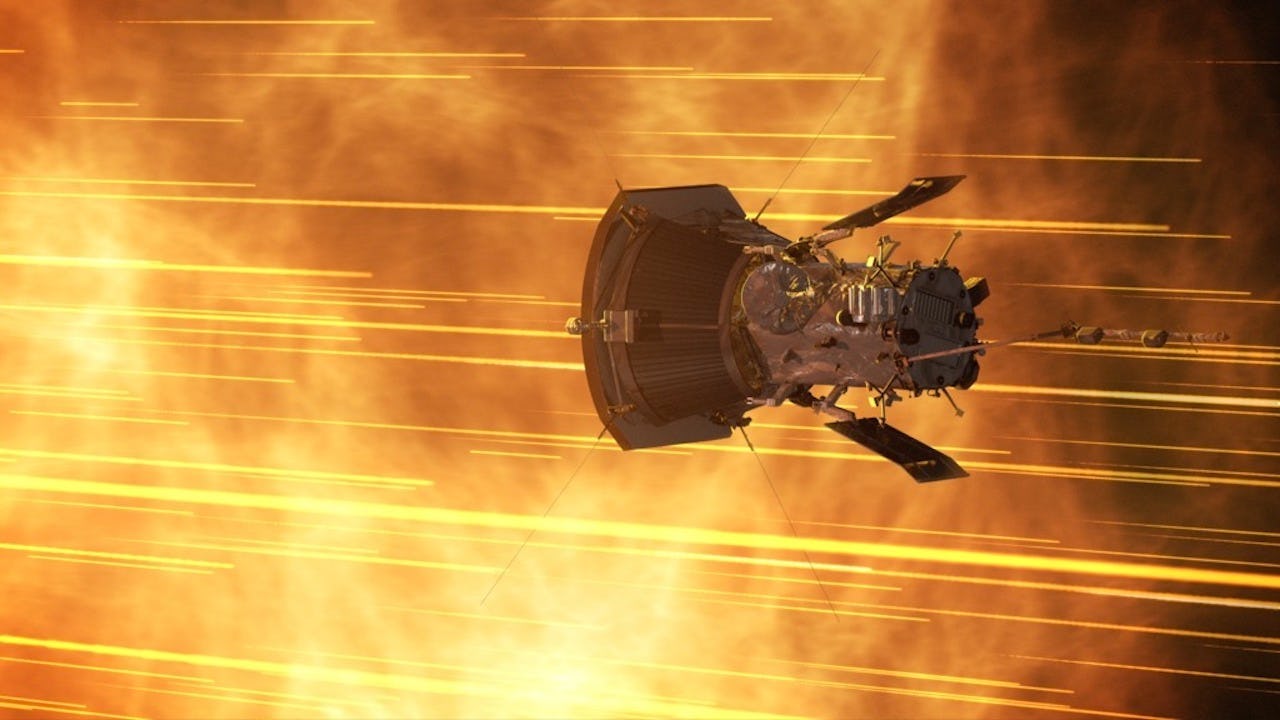
In a first for humanity, a manmade spacecraft has kissed the Sun.
“Not only does this milestone provide us with deeper insights into our Sun’s evolution and its impacts on our Solar System, but everything we learn about our own star also teaches us more about stars in the rest of the universe,” Thomas Zurbuchen, the associate administrator for the Science Mission Directorate, says in a press release.
What’s new — NASA’s audacious Parker Solar Probe achieved the scientific first after three years and five Venus flybys, entering the Sun’s atmosphere on April 28, 2021. The achievement was announced at a press conference at the American Geophysical Meeting Fall Meeting in New Orleans this week.
So why are we only learning about this incredible feat now? Well, NASA needed the intervening months to confirm they had actually done it — analyzing energy interactions recorded by the probe to try and mark the moment. Ultimately, the signature of the Sun’s magnetic field was the smoking gun that verified we had really, actually, touched the Sun.
Since then, the probe has encountered the Sun twice more — once in August and once in November.
What they found — Already, this achievement is serving up serious insight into the Sun. The first paper detailing fresh results from the probe was published Tuesday in Physical Review Letters, and there is another paper set to be published in The Astrophysical Journal soon.
The liminal space between the Sun’s atmosphere and space is called the Alfvén critical surface. Prior to the mission, physicists knew this dividing line was there but didn’t know precisely where. Best estimates put it at 4.3 and 8.6 million miles above the surface of the Sun. But the Solar Probe complicates matters.
In April, the probe entered the Sun’s corona (another word for the atmosphere) at an altitude of 8.1 million miles above the surface of the Sun. In doing so, the probe confirmed the Sun’s atmosphere isn’t uniform in shape — it is not some big sphere encasing the burning orb. Rather, it flows with peaks and valleys that the probe passed through repeatedly. At its closest approach, the probe came within 6.5 million miles of the surface of the Sun.
New discoveries — In its fly-through, the probe discovered two strange solar weather phenomena:
- A source of solar wind, known as switchbacks
- A pseudostreamer
Switchbacks are streams of charged particles that escape the Sun in a zig-zag-like pattern. Parker’s flyby proved that the photosphere — or surface — of the Sun generates these solar winds for the first time, although other regions of the Sun can generate them, too.
A pseudostreamer is a name given to huge structures that come forth from the Sun. The agency compared it to the “eye of a storm,” because these structures are relatively calm compared to the surrounding environment.

What is the Parker Solar Probe?
The Parker Solar Probe isn’t the first NASA mission to study the Sun. ESA also has a Sun-orbiter named Solar Orbiter (hopefully they didn’t spend too long on that name), but it has yet to have a close encounter — thus far, it’s only made it within 48 million miles, which wouldn’t even put it past Mercury’s orbit.
Parker wasn’t designed just to come near the Sun — it was designed to enter its atmosphere to settle the mystery of why the upper reaches of the corona are hotter than the surface of the Sun.
To do that, the probe is outfitted with a shield of carbon bricks able to withstand the unfathomably searing temperatures — up to 1.8 million degrees Fahrenheit.
To reach the Sun, the probe will go through a total of seven Venus flybys, which act like gravity slingshots to drop it close enough to the Sun to get inside the atmosphere. A flyby in January will bring the craft within the corona again. The next Venus flyby is slated for 2023.
These initial results are just the tip of the iceberg (plasmaberg?) for Parker, which will eventually reach 3.83 million miles from the Sun’s surface. Thanks to the new insight gained, the mission team will be able to further unlock the mysteries of our home star.
Abstract — The high temperatures and strong magnetic fields of the solar corona form streams of solar wind that expand through the Solar System into interstellar space. At 09:33 UT on 28 April 2021 Parker Solar Probe entered the magnetized atmosphere of the Sun 13 million km above the photosphere, crossing below the Alfvén critical surface for five hours into plasma in casual contact with the Sun with an Alfvén Mach number of 0.79 and magnetic pressure dominating both ion and electron pressure. The spectrum of turbulence below the Alfvén critical surface is reported. Magnetic mapping suggests the region was a steady flow emerging on rapidly expanding coronal magnetic field lines lying above a pseudostreamer. The sub-Alfvénic nature of the flow may be due to suppressed magnetic reconnection at the base of the pseudostreamer, as evidenced by unusually low densities in this region and the magnetic mapping.







